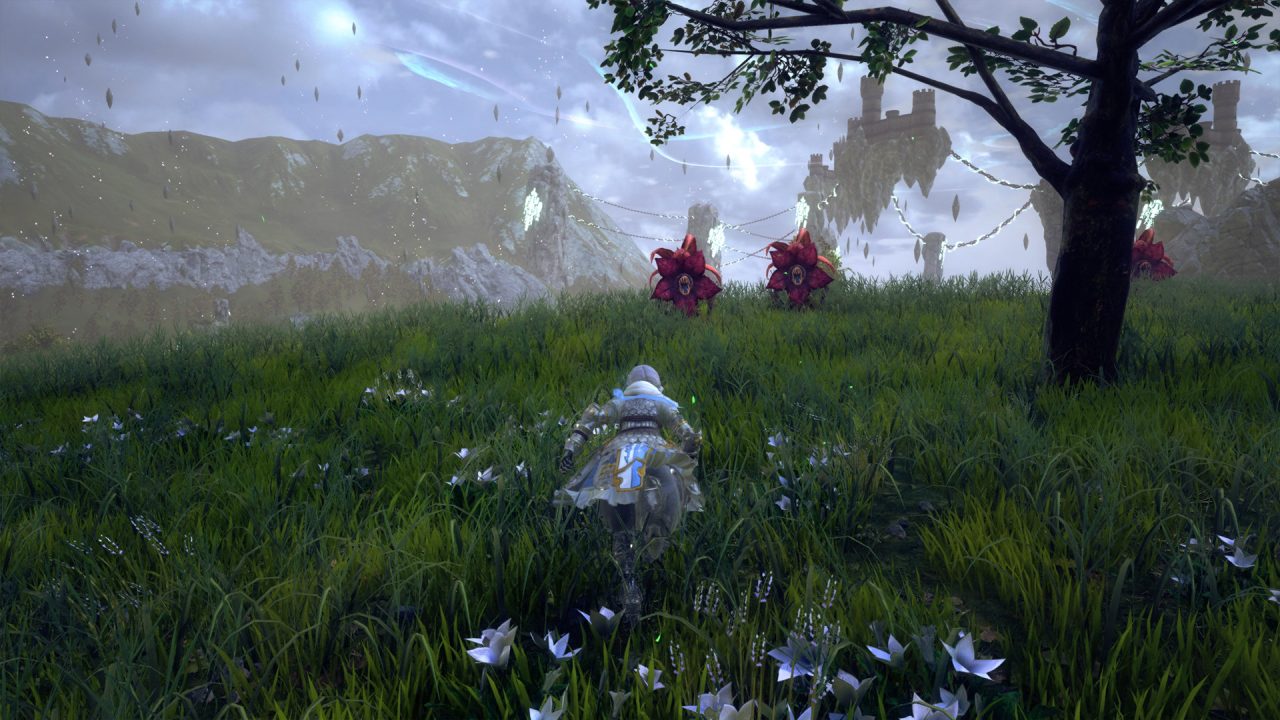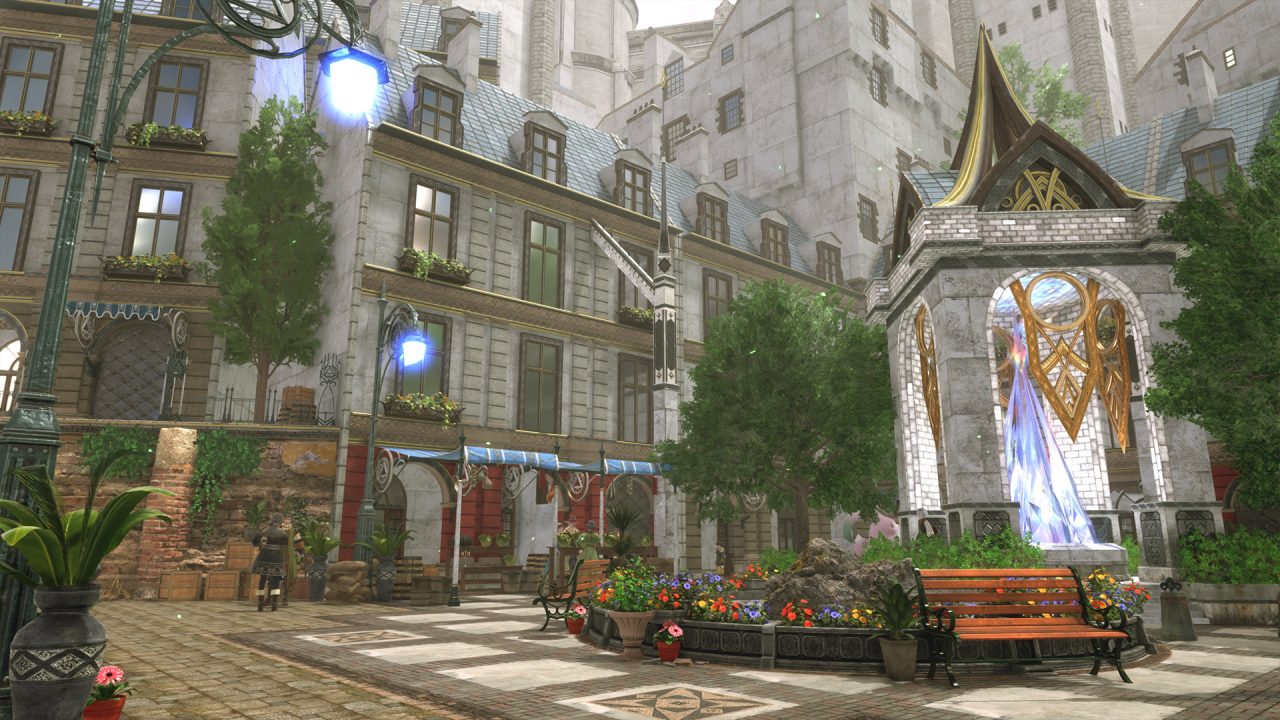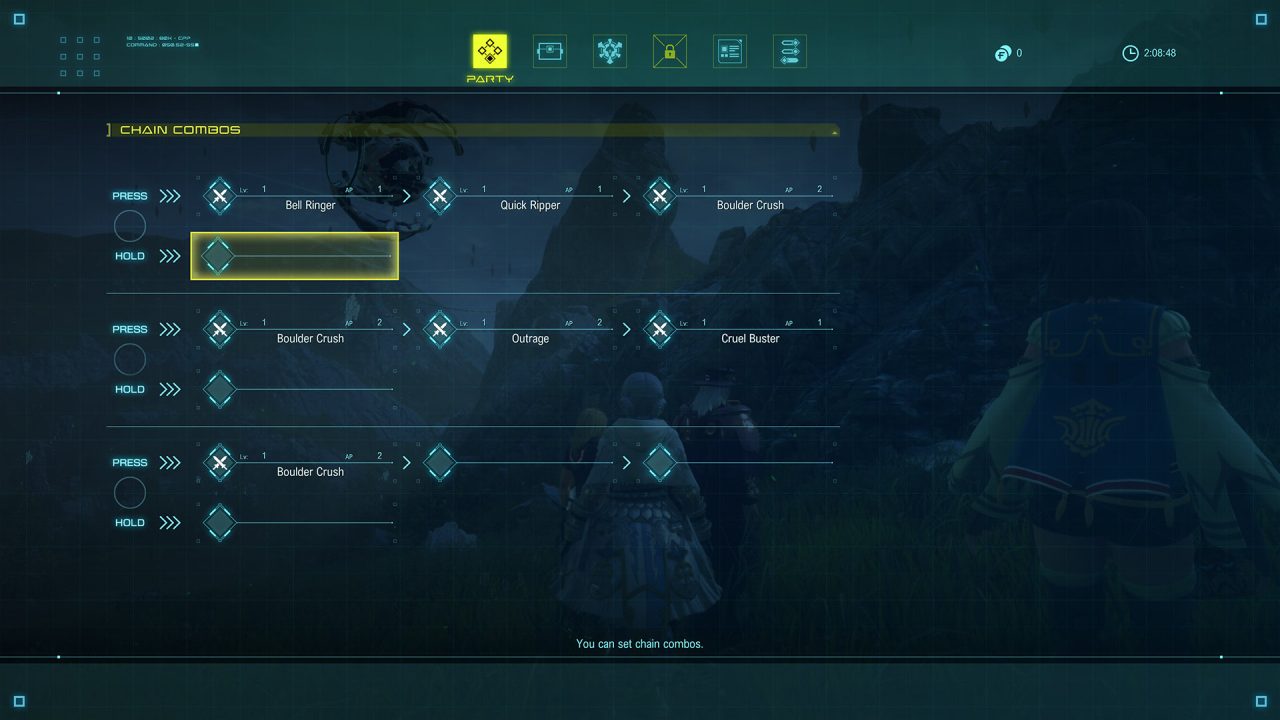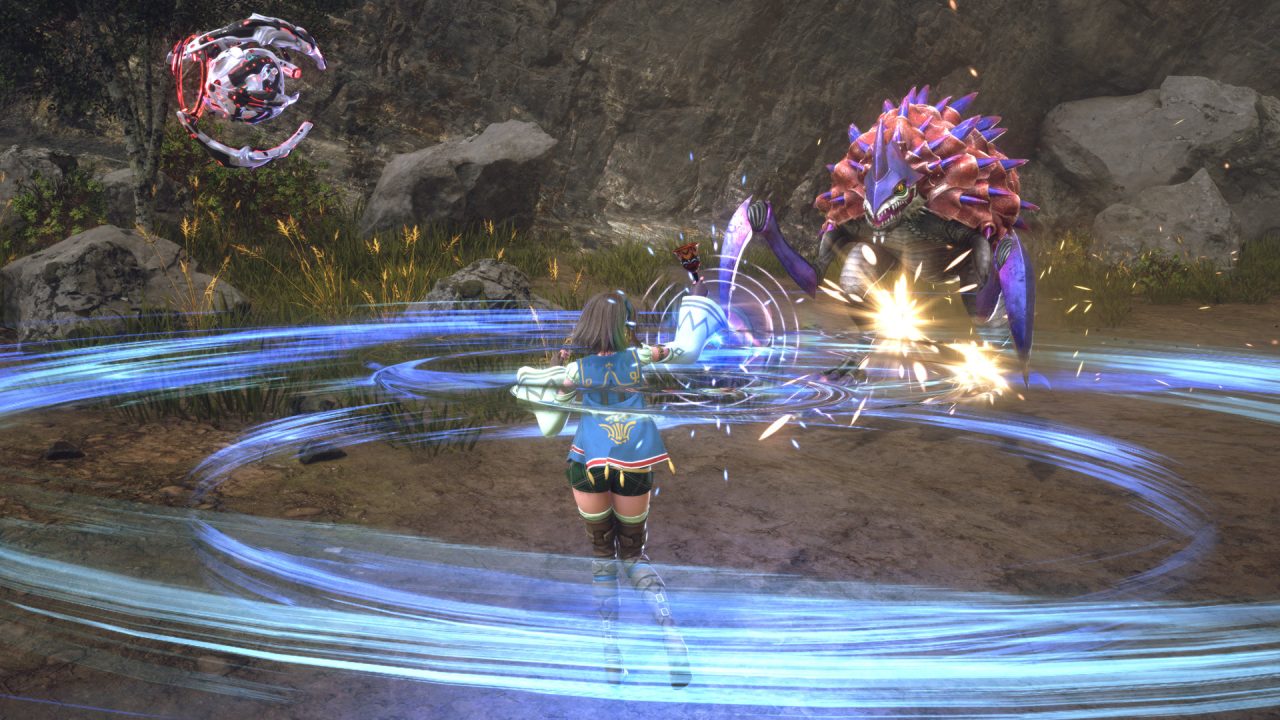For over 25 years, Star Ocean has been the premier sci-fi JRPG franchise. While its contemporaries have gone through their fair share of identity crises, Star Ocean has largely stayed true to its core premise. In the far future, humanity began to cross the sea of stars, and ultimately discovered life on underdeveloped planets. Said planets are often akin to fantasy worlds of swords, monsters, and magic, yet the way ancient magic and modern tech mix together leads to intriguing tales that span worlds. As the sixth installment in the long-running series, Star Ocean: The Divine Force both stays true to the series’ roots and also cuts its own path with a modern take on a beloved franchise.
Though it may be the sixth entry, Star Ocean: The Divine Force is one of the few dual-protagonist games in the series. Upon starting the game, players have the choice between Raymond Lawrence and Laeticia Aurelius, the former being more focused on the sci-fi aspects up front while the latter is more focused on the fantasy elements initially. The two paths also diverge at points, and while players will get the majority of the story on one character, there are some areas where the content is completely different because of how the party splits up. Naturally, this also includes the Private Actions, Star Ocean‘s more personal one-on-one scenes that are akin to Fire Emblem‘s Support conversations and Tales of games’ Skits.
With two protagonists, each with their own exclusive content, the story can feel slightly disjointed at first. While Raymond gets an introductory cutscene that quickly throws his crew into action, Laeticia’s introduction feels more sudden and accidental. The only reason I even knew what happened to Raymond at the start of the game was that I played a bit of the demo, which only allowed players to select Raymond. As Laeticia’s gameplay style was more appealing, I chose her as my protagonist and was soon thrown into the deep end. Initially, I found the way Raymond and Laeticia crossed paths to be jarring, awkward, and a little confusing, but in retrospect, it was a solid choice. Their strange and sudden meeting accurately conveys both the wonder and the disorientation that follows when two technologically contrasting races make contact.

Although the protagonists of Star Ocean: The Divine Force join forces early on, the party does split up on multiple occasions. These splits ensure each protagonist has their own view on events, as well as their own exclusive scenes and dungeons. That said, it can be a little strange to have half the party leave to do something and then have no idea what is happening on their end. There is little recap, if any, when the party reconvenes, leading to significant gaps in the story. While they’re not plotholes per se, said gaps seem designed to encourage a (rather lengthy) replay from the other side. For example, I wouldn’t have known that Raymond was doing a labyrinthine dungeon while Laeticia was dealing with political turmoil if a friend hadn’t told me.
As a series that mixes fantasy and sci-fi, Star Ocean: The Divine Force‘s story is largely political, in the correct usage of the term. Laeticia’s side dips into the geopolitical stances of kingdoms while Raymond’s side focuses more on the militaristic actions of the Federation. While Star Ocean also plays with a few tired tropes, this entry manages to avoid the overly melodramatic traps that its predecessors and contemporaries often fall into. Additionally, Laeticia’s comes across as a mature political drama that could stand on its own as an intriguing tale without any of the sci-fi elements.
The storylines in Star Ocean games often follow the same general beats, but the character writing and performances are where the games stand apart from each other — for better or worse. Thankfully, Star Ocean: The Divine Force has a strong cast through and through. The protagonists and their supporting casts are unique yet grounded. Gone are the days of awkward shower scenes, green-haired space elf creeps, and Nappy Time, Kay? In their stead is a collection of well-rounded and strong characters who act mature and offer insight into any situation. That said, some characters do feel a little undercooked compared to others. For example, Laeticia and Raymond feel fully fleshed out, yet Marielle and Malkya feel like they could’ve been introduced a bit earlier to get more character development.

Speaking of development, Star Ocean: The Divine Force looks and feels as if it had a proper budget and development time — especially compared to its predecessor, Star Ocean: Integrity and Faithlessness. The world feels large and lively, villages and castle towns feel bustling, and the fields feel as if every hill and corner were meant to share a wondrous vista. The ability to dash, jump, float, and air dash across the land provides some light platforming opportunities that lead to treasure chests and upgrade points for the A.I. companion D.U.M.A. There is a lot of care put into the world, and the presentation is a clear step up from previous games.
While the Star Ocean series has always had action RPG combat, Star Ocean: The Divine Force has managed to nearly perfect the battle system. Thanks to the new AP system and Chain Combo system, battles remain fresh and exciting as players can mix and match their skills in chains. With three chains per button and a skill utilized by holding a button, players can have up to twelve active skills in battle. I found a lot of enjoyment in studying my individual moves and building my own combos, ensuring that I had a grand arsenal of skills at my disposal to deal with nearly any situation.
One element that drastically elevates combat in Star Ocean: The Divine Force is the addition of D.U.M.A., a highly advanced artificial life form that serves as both a guide and companion on the journey. With D.U.M.A., players can quickly zip around the battlefield at high speeds, blindside foes for increased damage, surprise attack enemies outside of battle, and shield allies while extending buffs and reducing debuffs. The versatility that D.U.M.A. adds to the battle system is an impressive feat, and the added mobility ensures that combat is always fast and flashy.

As expected of a sci-fi/fantasy hybrid, Star Ocean: The Divine Force boasts eye-catching visuals while also being easy on the eyes. While the characters themselves do still have that doll-esque look, there’s a certain charm to their designs. Whether they’re an armored princess wielding dual blades, a mullet-rockin’ space captain with a broadsword, or a buff steampunk mage who looks more likely to cast fist instead of fireball, the party members each have a wonderful look that adds to their character. That said, Malkya looks quite out of place with her choice of garb. While she’s intended to be a more exotic space elf, she instead comes off as looking like World of Warcraft night elf recreated in Phantasy Star Online 2‘s character creator. Simply put, her design is a little jarring compared to the company she keeps.
The world of Star Ocean: The Divine Force is quite a visual treat. I often found myself stopping on hilltops or floating stones to survey the area and take in the lush landscapes that surrounded me. The vistas are often gorgeous, and as I traversed the massive maps, I couldn’t help but stop and poke around almost every corner. The sense of scale is also notable, especially when making the trek up the side of a mountain to a quaint little village with large windmills that can be seen from the mountain’s base. While the game does offer fast travel, I rarely used it because of how often I enjoyed crossing an area but taking a slightly different path in order to see more of Aster IV, the planet on which the game is set.
Star Ocean: The Divine Force’s OST can almost be summed up with a single name: Motoi Sakuraba. Now, such a prolific and storied composer as Sakuraba has numerous sounds and styles in his repertoire, so which Sakuraba are we getting here? Is it the horn-laden holy choir Sakuraba? The weird prog-rock synth abuser Sakuraba? Or is it the calm and soothing acoustic Sakuraba? The answer: all of the above. The small towns have subtle and welcoming guitars that give off a peaceful ambiance, while Raymond’s themes are generally the weird and fun Sakuraba that gets the blood flowing. Laeticia’s side feels more akin to the Valkyrie-style Sakuraba, complete with strings, horns, and heavenly chants. For a fan of all things Sakuraba, Star Ocean: The Divine Force is a true showing of his creativity and prowess. For a taste, check out the small sampler.

With a grand world to explore, exciting and kinetic combat, charming characters, and a distinctly Sakuraba soundtrack, Star Ocean: The Divine Force has a lot of great elements to it. Yet, there are a few areas where it falls short. Firstly, the skill tree completely devalues the leveling system. Gaining a level does little more than grant SP to feed into the skill tree, upgrading abilities or obtaining new crafting skills. Secondly, the crafting system is weak at best. Crafting items and gaining new factors feels like pulling a slot machine lever and hoping something good comes out. Finally, canned character animations are overused to such a degree that it becomes apparent that the developers didn’t have the budget to create more animations for conversations and scenes. These complaints may be a bit nitpicky on my part thanks to being spoiled by other games, but they’re noticeable flaws that hamper the experience, albeit only slightly.
After the dismal critical and financial performance of the previous Star Ocean game, Star Ocean: Integrity and Faithlessness, it’s a surprise that Star Ocean: The Divine Force exists at all. It seems as if ample development time, a sizable budget, and freedom to expand on the world and mechanics (while reigning in some of the anime hijinks) were all tri-Ace needed. If Star Ocean: Integrity and Faithlessness could be compared to the first Star Ocean for its return to basics and small scope, then Star Ocean: The Divine Force could be compared to Star Ocean: The Second Story for its expansion of mechanics, themes, and world.
My time with Star Ocean: The Divine Force was thoroughly enjoyable, though it started to lose a bit of steam near the end of my 42 hours. The final dungeon(s) do fall into the sadistic teleport dungeon trap that many JRPG areas do, and the primary villain spends far too much time arguing their point with the party, far too many times. By the final battle, I just wanted to see credits, which unfortunately puts me off a replay for quite some time. That said, I’m excited to see Raymond’s side of things, and I can’t wait to swing a sword, rock a mullet, and listen to some trashy synth-heavy prog rock while tackling the extensive post-game. As I’ve said Star Ocean so many times that the words are almost losing all meaning, I’ll simply state this: Star Ocean: The Divine Force is the most Star Ocean that a Star Ocean game can be, and that makes it the best Star Ocean in nearly twenty years.


